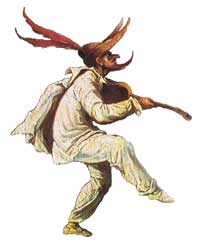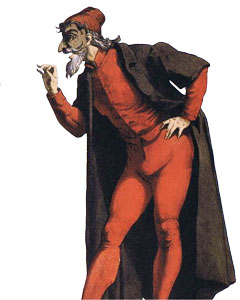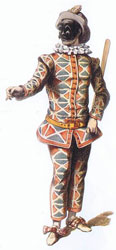What Were the Commedia Dell Arte Masks Made of?
Commedia dell'Arte Characters
Here is some groundwork on the Commedia dell'Arte characters that many of the Venetian Masks designs are based on:
1. Zanni
Zanni is probably not the first character that springs to listen when you think of Commedia dell'Arte characters. That is because the Zanni graphic symbol is seminal to many other characters in the Commedia dell'Arte theater, including Arlechino, Brighella, and Pulcinella. The name 'Zanni' is a diminutive of Venetian proper name 'Giovanni' (John) and we get our English word 'zany' from this, which gives you an idea of the nature of this character! The Zanni character was a buffoon or clown and known in those days every bit a simpleton or 'stupid incompetent fool'!
 This character was drawn from the lower classes of the time, the peasant or migrant worker who worked in Venetian society equally a servant, valet or porter. Sometimes besides as an odd chore person or hawker.
This character was drawn from the lower classes of the time, the peasant or migrant worker who worked in Venetian society equally a servant, valet or porter. Sometimes besides as an odd chore person or hawker.
The term Zanni therefore refers to a form of mask although in some cases was a specific character as well. This clown was an of import aspect of Commedia dell'Arte theatre, representing the peasant class of order. Zanni reflected the role of the Bergamo peasants, who at that time were facing a famine in the rural areas they lived in due to cheaper imports from Greece (audio familiar?) later their region was conquered by the Venetian army in the early on 1400's. They flooded in to the urban cities such every bit Venice, offering themselves for any work they could detect and eeking out a living in anyway they could. In their favour, they were famous for their nimbleness and agility on the positive side and on the other side - their crudeness. Overlaid on all of this was their fantastic dialect and manner of speaking - these traits formed the basis of an important grapheme in Commedia dell'Arte.
In the early on days of Commedia dell'Arte, the Zanni mask used in the theatre was a full face mask with a long nose. Information technology developed from here into a one-half mask roofing the upper half of the face just with an extended, long olfactory organ. The longer the nose on the mask, then the more than stupid was the character.
The costume of the Zanni character reinforced for the audience the nature of this character. Usually dressed in sacking and hunched over through carrying heavy loads as a porter, with knees in a 'bowed' position and feet splayed apart. This was in sharp contrast to the aristocracy characters in the Commedia dell'Arte who always carried themselves with cock actions. Zanni was always highly animated, waving arms and gesticulating with hands when speaking in a coarse manner with erratic trunk movements thrown in! Some Zanni characters were known for their acrobatic feats, including hand-stands and flips. Others displayed their roots and were constantly ravenously hungry (coming from a famine in their home towns) but their coarseness also introduced mirth into the theatre with farting, burping and resounding snoring.
2. Pantalone
 Pantalone is a well known Commedia dell'Arte grapheme. The original name of this grapheme was an old human named "Magnifico". He spoke in plain, yet musical Venetian dialect. The original name soon gave way to the more well known "Pantalone". At that place are numerous interpretations about the origin of this name. Information technology is said that it derives from San Pantalone, one of the Saints venerated in the urban center of Venice. A Venetian church is fifty-fifty named after San Pantalone.
Pantalone is a well known Commedia dell'Arte grapheme. The original name of this grapheme was an old human named "Magnifico". He spoke in plain, yet musical Venetian dialect. The original name soon gave way to the more well known "Pantalone". At that place are numerous interpretations about the origin of this name. Information technology is said that it derives from San Pantalone, one of the Saints venerated in the urban center of Venice. A Venetian church is fifty-fifty named after San Pantalone.
Some other possible origin is the term "piantaleoni", a name used for the merchants who opened their stalls in conquered lands and symbolically "planted" the Lion of St Marker to extend the power of the city of Venice through merchandise. The character Pantelone is of course an onetime merchant, then it does give some credence to this theory.
Other theories are that the proper noun pre-dates this era and goes dorsum to the Greek expression meaning "powerful in all things".
Pantalone'south character is generally an erstwhile merchant, oft wealthy and esteemed, at other times completely ruined, even so always an former man in every particular, with business organisation skills. His mask typically highlighted his physical characteristics including a hooked nose and prominent eyebrows.
Browse through the Italian republic Mask "Traditional" pick to see if nosotros currently have a Pantalone mask in stock.
3. Il Dottore (The Doc)
Il Dottore in Commedia dell'Arte is unremarkably dressed in the traditional fashion of a medieval dr., with a huge blackness suit, often with a ruff and a notary'southward beret or large doctor's cap. He wears a mask over one-half of his confront that highlights his bulbous nose.
Il Dottore is a comic personage originally from "well-fed and learned" Bologna. He is a 'doctor' merely in name and is depicted at times as a learned physician and at other times as a notary or lawyer.
Browse through the Italy Mask "Traditional" selection to see if we currently have an "Il Dottore" mask in stock.
4. Arlecchino (Harlequin)
 The Arlecchino mask is one of the most popular masks in the Commedia dell'Arte series. It was traditionally worn by the graphic symbol Arlecchino (Harlequin in English) who was cast as a bit of a dim-wit, giddy, simple minded person and perpetually hungry, again, in the Zanni genre.
The Arlecchino mask is one of the most popular masks in the Commedia dell'Arte series. It was traditionally worn by the graphic symbol Arlecchino (Harlequin in English) who was cast as a bit of a dim-wit, giddy, simple minded person and perpetually hungry, again, in the Zanni genre.
Arlecchino is ane of the youngest characters of the comedy and the use of this character in the Commedia dell'Arte has been traced back to as early as 1593.
Arlecchino'southward usual office is that of a faithful valet or retainer, merely in this context he is besides the clown, the acrobat providing lots of comic relief! Every bit shortly as this character appears on phase there is always lots of laughter at his absurd actions and words, alternating betwixt flashes of luminescence and plain idiocy. You can't predict which will manifest itself at whatever time! This is overlaid with wit and amuse, every bit well equally scheming to meet his own objectives.
While undertaking errands for his chief or pursuing a pretty lady (or both!) he gets into all fashion of strife. He employs every technique he tin can to achieve his objectives, including pretending to be a soldier or a adult female. His absent mindedness is legendary and he tin exist looking for the chair he is sitting on or completely sidetracked by a pretty lady, money or nutrient! All the while, his dizzying free energy is causing his supple body to undertake somersaults, handstands, cartwheels and all sorts of acrobatic feats! Understandably, he was loved past audiences.
Arlecchino's costume usually comprised a jacket and trousers with colorful and irregular patches, with a white felt hat with a rabbit or fox tail and a belt with a wooden spatula (or 'slap stick'). This was used to stir polenta or sometimes to slap another person, a parcel, baggage, food or other items belonging to someone else!
Arlecchino'south mask has a puggish nose, sometimes a crash-land on his forehead and usually with devilish and feline features. He is truly a colorful character!
Scan through the Italy Mask "Traditional" option to see if we currently take an "Arlecchino" mask in stock.
5. Pulcinella
 The Pulcinella mask in the Commedia dell'Arte theater is reputed to have originated from the south of Italia (Campagnia), a region boasting a wealth of comic traditions.
The Pulcinella mask in the Commedia dell'Arte theater is reputed to have originated from the south of Italia (Campagnia), a region boasting a wealth of comic traditions.
Pulcinella'due south concrete advent in the theater often resembled that of a cockerel. His mask with a beaked olfactory organ is thought to have given rising to his name, either from the Latin 'pullus gallinaceus' or from a dialect corruption of 'pullicino' (immature chick).
Regardless, his big nose, squeaky vocalization, clownish ways gave rise to him being cast as a charlatan, lazy bones, tumbler and acrobat. The Pulcinella character appeared in many acts of the Commedia dell'Arte and it was this character that prompted Giandonmenico Teipolo to paint him on the walls and ceilings of the Villa Zianigo in Venice.
We usually have a number of Pulcinella masks in stock. Review our choice of Traditional Venetian Masks now.
vi. Colombina
Colombina is unremarkably cast equally a mischievous maid in the Commedia dell'Arte, a comic but not always virtuous figure with a best friend (and sometimes lover) of Arlecchino.
Her costume is unremarkably simple, representing what maids wore in the 1700s. She sometimes wore colorful patches (similar Arlecchino) ready off by a small white cuff and an apron of the aforementioned colour.
Colombina is translated into English every bit "picayune Pigeon" and the masks in this range are without exception purely "Eye Masks", just covering the eyes and exposing the rima oris and then that the wearer is able to eat and drink freely. This design is said to have originated because of the grapheme Colombina's vanity and not wanting to obscure too much of her beauty with a mask.
These masks form the basis of a big number of variants all based on the Colombina Center Mask, but are now available in feather, leather, jolly, baroque, metal filigree and macrame / lace.
Because of their utility to be worn at masked events, such every bit masquerade assurance, these masks are the most pop Masquerade Mask.
Browse through our collection of 150 Colombina Masks now - there will be one in that location that is but correct for you.
seven. Il Capitano (The Helm)
Il Capitano'due south character in Commedia dell'Arte is usually a vainglorious, deceitful and braggart soldier, dressed in a bright and colorful uniform. This was usually a adjust with multi-colored stripes and golden buttons, a feathered cap and a large sword with several rust marks or even some cobwebs! His part unremarkably involves him boasting of bang-up exploits of state of war, but he is also the subject of pranks and jokes from the other characters. He sometimes responds to this by unsheathing his sword, only the only blood that is ever spilt is his own!
8. Brighella
Brighella is bandage as a shrewd servant in the Commedia dell'Arte in the 'Zanni' genre. 1 of his specialties for this role are the tricks and pranks that he plays on other characters and is sometimes also an skillful musician, singing and playing the guitar. This meddlesome, greedy and acute servant is likewise a ruffian, ready to satisfy even the meanest desires of his master. He is usually totally unscrupulous and set for whatsoever craft.
His costume is that of a servant, but usually with several short green stripes on a white background on both shirt and trousers. He sometimes also wears a cloak and a cap with green stripes.
For some reason, Brighella's popularity was partly eclipsed in the Commedia dell'Arte by Arlecchino, who became much more than popular with audiences.
Source: https://www.italymask.co.nz/About+Masks/Commedia+dellArte+Characters.html
0 Response to "What Were the Commedia Dell Arte Masks Made of?"
Post a Comment